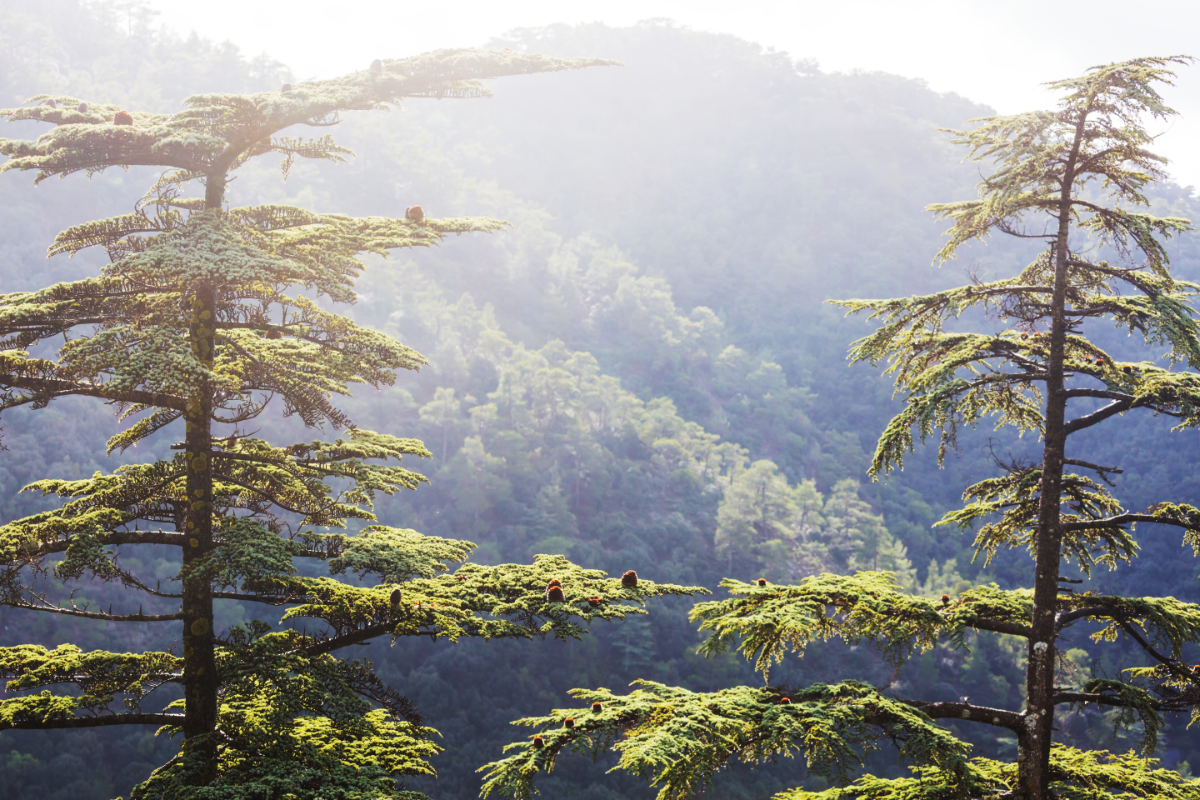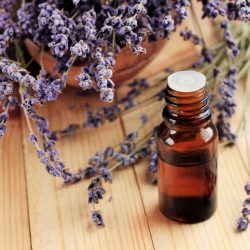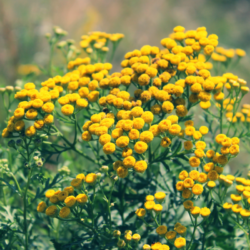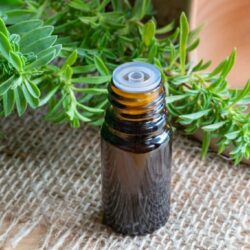Discover nature’s hidden treasure: Virginia Cedar essential oil, a precious ally for your health and well-being. In this article, we explore the many benefits of this miraculous oil, renowned for its soothing and regenerative properties. Whether you’re looking for a natural solution to boost your immune system, improve the quality of your skin, or simply to regain serenity and balance, Virginia cedar essential oil offers a natural and effective answer. Join us as we delve into the fascinating world of this natural essence, where tradition and science meet to reveal its deepest secrets.
What are the characteristics of Virginia Cedar?
Virginia Cedar or Cedarwood, with its botanical name Juniperus virginiana, is a member of the Cupressaceae family.
What are its botanical attributes?
Virginia cedar is generally a medium to large tree. It commonly reaches a height of between 15 and 20 metres. Exceptional specimens sometimes exceed these dimensions. Its distinctive silhouette is characterised by a narrow conical habit. This habit gives it the appearance of an inverted cone with a wider base and a tapering tip.
Its distinctive reddish-brown bark is peeled off in fine strips. The twigs of Virginia Cedar are relatively delicate, with a diameter of around 1 millimetre.
As far as its foliage is concerned, Virginia Cedar is remarkable for its small, scaly needle-like leaves of a distinctive blue-green. These evergreen needles grow in opposite pairs and are generally 5 to 8 millimetres long. They are arranged in four closely packed rows on the shoot, with each scale measuring around 1.5 millimetres.
How does it reproduce?
The reproductive process of the Virginia Juniper is characterised by the distinct presence of male and female flowers . The male flowers are yellow, while the female flowers are green. This dichotomy of colour between the sexes is a remarkable feature of this plant’s reproduction.
When it comes to fruiting, the Virginia Juniper produces ovoid-shaped fruits. They are visually reminiscent of pruinose cones, with a characteristic bluish tinge. These fruits have an average size of around 5 to 6 millimetres. Although these structures may resemble berries, it is important to note that they are actually fruits, in accordance with botanical classification.
These fruits reach full maturity in the first year after pollination. They generally contain one or two seeds. This is a significant feature of the Virginia Juniper’s reproductive cycle. The presence of male and female flowers on the same tree favours fertilisation, thus contributing to the reproductive success of this species.
What is its habitat?
The Virginia Juniper is native to the east coast of the United States and can be found in southern Canada. One of its well-known names is “Red Cedar”, due to the colour of its wood. This species is currently found in south-west France.
This juniper is remarkably adaptable to a variety of soil types. It shows a clear preference for calcareous and sandy soils, as well as adequate exposure to the sun. This preference for specific soils and optimal light conditions is a key factor in its ecological success.
Virginia Juniper has an impressive ability to thrive in a variety of environments. It can thrive both on rocky slopes, thanks to its deep root system, and in marshy areas with damp soil. This ability to adapt to such diverse soil conditions is a notable feature of this species.
The Virginia Juniper is also renowned for its drought resistance. It is able to survive and maintain relatively stable growth even during prolonged periods of low rainfall, making it a particularly hardy species in water-stressed regions.
In terms of climatic conditions, this juniper species is also exceptionally hardy. It can tolerate wide variations in temperature, withstanding both intense heat and rigorous cold. This ability to thrive in extreme climatic conditions makes it a valuable component of the ecosystems in which it is found.
What are the uses of cedarwood essential oil?
The essential oil is distilled from the wood. The yield is around 3%. The essential oil is liquid, mobile and clear. It is yellowish to brownish in colour.
How does it work?
The biochemical composition may vary depending on the production conditions.
The main chemical compounds include :
- Sesquiterpenes: alpha- (20-30%) and beta-cedrene (5-10%), thujopsene (15-20%), cuparene, corresponding to 36 to 68% of the composition.
- Sesquiterpenols: cedrol (20-30%), cedrenol, widdrol (5%) and gamma-eudesmol (5%), representing 20 to 40% of the composition.
The properties of Virginia cedar essential oil derive from the presence of active compounds native to its wood.
This essential oil has venous decongestant, draining and lymphatic properties thanks to its high sesquiterpene and sesquiterpenol content. These give it the ability to regulate blood and lymph circulation in the body. It has an anti-parasitic action thanks to its sesquiterpenes, which act against external aggressors, particularly parasites. It is lipolytic and anti-cellulite thanks to the sesquiterpene ketones it contains, which encourage the breakdown of body fat. The sesquiterpene carbides in Virginia Cedar essential oil reduce vascular permeability. They also inhibit the secretion of inflammation mediators, giving it anti-inflammatory properties.
Other properties of Virginia cedar include :
- Respiratory decongestant and anti-infectious.
- Blood fluidifier.
- Arterial regenerator.
- Cell regenerator.
- Urinary antiseptic.
In olfaction, it can be a general tonic and stimulant. Thanks to its high thujopsene content, Virginia cedar essential oil acts as a tonic and stimulant for the whole body. In high doses, however, it can cause feelings of disinhibition due to its convulsive properties.
It can also act as a natural sedative. The cedrol molecules it contains act on the central nervous system, providing hypotensive, analgesic, relaxing and sedative properties.
What are the contraindications?
Cedarwood essential oil requires careful use and specific precautions. Under no circumstances should it be used during the first three months of pregnancy, or on infants under 6 months of age. It should also be avoided by people suffering from kidney failure or with a history of hormone-dependent cancers.
Its use is not recommended for pregnant or breast-feeding women, children, epileptics or people with kidney problems. It is essential not to prolong its use beyond the specific recommendations.
Note that this essential oil can cause irritation to mucous membranes, the urinary tract and the central nervous system. What’s more, when used orally, it is essential not to exceed three drops a day for an individual weighing 70 kg. Higher doses can be potentially dangerous.
How do I use this essential oil?
Important precautions must be taken when using Virginia cedar essential oil. It should never be applied undiluted to the skin. It is essential to dilute it to a concentration of 20% in an appropriate vegetable oil before applying it to the area concerned. The oral route should only be used after consultation with a qualified therapist.
What are the skin applications of Virginia cedar essential oil?
- To treat hair problems such as greasy hair, hair loss, fungal infections of the scalp and dandruff, dilute the essential oil in your shampoo or a hair mask, then apply it to the hair, massaging the scalp.
- For dermatological problems or oily skin, dilute the essential oil in a suitable vegetable oil, then apply locally.
- For beauty problems such as dermatitis or dry eczema, dilute the essential oil in a suitable plant oil and apply to the area to be treated.
- To treat cellulite and varicose veins, dilute the essential oil in a vegetable oil and massage into the affected area.
- For blood circulation problems, dilute the essential oil in a vegetable oil. Then massage your legs using upward movements.
- To relieve problems linked to the respiratory tract or to strengthen the immune system, such as mucus, rhinitis or nasopharyngitis, dilute the essential oil in a vegetable oil and massage along the spine, the upper back and the arch of the foot.
- For joint or muscle pain, dilute the essential oil in an appropriate plant oil and massage the painful area.
How to diffuse Virginia cedar essential oil successfully?
Virginia cedar essential oil can be diffused to take advantage of its beneficial effects on health and well-being. You can choose one of the following diffusion methods:
- Nebulizer diffusion: these diffusers propel the essential oil through a pump, providing an effective, though generally expensive, diffusion.
- Ultra-sonic diffusion (misting): although less powerful, these diffusers are still effective for enjoying the effects of the essential oil in enclosed spaces.
- Diffusion using gentle heat: pour a few drops of essential oil into the receptacle provided in these diffusers. The heat releases the aromatic particles into the atmosphere. This method is ideal for small, enclosed rooms.
- For psychological well-being, in the event of anxiety, depression or fatigue, you can use the essential oil by olfaction, diffusion or inhalation. You can also dilute it in a vegetable oil and massage it into the solar plexus, spine and arch of the foot.
What is its history?
Migratory granivorous birds are thought to be responsible for the scattered patches of Virginia juniper found near lakes. The species also acts as an intermediate host for leaf rust, which produces very conspicuous orange fruiting bodies in the spring in wet weather. Virginia cedar is nothing like Atlas cedar. It is actually a tree of the juniper genus. It is used as an ornamental tree, with its majestic appearance and very dense branches. It was introduced to Europe in the 17thcentury.
How was the genus Juniperus used in ancient times?
A plant that has been man’s companion for thousands of years, juniper, whether medicinal or magical, has never ceased to fascinate, so vast are its powers.
In Egypt, juniper, mentioned in the Ebers papyrus 1,500 years BC, was used to make kyphi. In Greece, Hippocrates is said to have fumigated juniper during a plague epidemic in Athens. Several centuries later, this was still done in French hospitals to purify the atmosphere… Juniper is still found in Medea ‘s hand to put the dragon guardian of the Golden Fleece to sleep. Juniper is also said to have a purifying effect on the body, soul and spirit, on people and on the living spaces they occupy. The ancients used to burn juniper wood and twigs.
When the ancient Romans ran out of incense and rosemary, they used juniper to ward off evil spirits and demons. It was also planted near homes, and bunches of twigs were hung from doors and windows, as well as at the entrances to stables and barns. Sometimes the branches were used for lustration or to strike the walls of the house.
From Cato to Dioscorides, the ancients were unanimous about juniper’s diuretic powers, a claim that Pliny was quick to endorse, adding other properties: as a digestive and purifying agent, juniper flushed out toxins and revitalised weakened areas of the body.
The king of Assyria had his palace built in Nineveh using cedar wood, known for its longevity. It is also used as an ornamental tree, particularly in Europe, where it was introduced in 1648. It can live to be 300 years old, with an upright growth habit, dense branches and a majestic appearance.
What medicinal uses did it have in colonial times?
In the Middle Ages, the medicinal value of juniper was already increasing, as it was used as a general tonic and to treat rheumatism. Hildegarde had recognised the pectoral and hepatic properties of common juniper. She also used it as a remedy for the pain of gout.
The territory of New France included the colonies of Acadia, Canada and Louisiana. At its height, around 1745, it covered the region drained by the St Lawrence, the Great Lakes and the Mississippi, as well as the northern Great Plains and a vast portion of the Labrador peninsula. The French discovered Virginia juniper during their exploration of the interior of New France. It was mainly found in the eastern United States. In Canada, it is found mainly in south-eastern Ontario and extreme south-western Quebec.
From the sixteenth to the nineteenth centuries, numerous doctors and botanists extolled the diuretic, depurative, anti-rheumatic, anti-arthritic and tonic properties of juniper. This plant was frequently used in the preparation of remedies for blood disorders and urinary problems. Juniper was commonly used to make medicinal diuretic wines and Haarlem oil. Haarlem oil was used to alleviate the pain caused by gout and rheumatism. Juniper was also used to treat renal colic.
What other uses were there at the time?
Samuel de Champlain was one of the first Frenchmen to observe this conifer in the Ottawa Valley, near Lac des Chats. However, he called it “red cypress”, a terminology that did not prevail in New France, rather than “red cedar”. Its geographical distribution is limited. This species was probably not familiar to all the inhabitants of the St. Lawrence Valley. However, travellers and soldiers responsible for defending the colony in the forts located along the borders of New France, south of the St. Lawrence valley, were familiar with the plant.
Some inhabitants used the wood of this conifer to make tables and pedestal tables. Little is known about this practice.Cedar chests”, made from Virginia juniper, only appeared late in the material culture of French Canadians, probably in the 1920s or 1930s in Quebec. Initially, these storage units were imported from Ontario and the United States, where they had been manufactured since the eighteenth century.
Another Anglophone custom was to build cedar-panelled wardrobes to protect clothes from moths. Today, bird feeders made from this wood are also available commercially. It is naturally pest and weather resistant.
References
- Anxiolytic effect of Juniperus virginiana L. essential oil. a study examined the anxiolytic effect of Juniperus virginiana essential oil. It showed an increase in the percentage of entries and time spent in the open arms of a raised cross-shaped maze in mice. Suggesting an anxiolytic effect of the oil. However, no anxiolytic effect was observed in the light-dark box test. Tests on cedrol, a component of the oil, showed a significant anxiolytic effect in both tests at doses of 400-1600 mg/kg. The study also revealed that the oil and cedrol could act via the serotonergic and dopaminergic pathways.
- Wound-healing and anti-inflammatory activities cedar essential oil demonstrated significant wound-healing and anti-inflammatory activities in vivo in a study published in the Journal of Medicinal Food.
- Relaxing effect of cedrol on humans cedrol, present in cedarwood oil, has been shown to have a relaxing effect on humans, increasing parasympathetic activity and reducing sympathetic activity, according to a study published in Autonomic Neuroscience.
- Effects on mental health and stress a study involving 498 people showed that spending time in the forest improved emotions and reduced stress, which could be linked to the beneficial effects of compounds found in cedar essential oil.
- Cedrol’s antimicrobial and cytotoxic activity cedrol has shown antimicrobial activity in vitro against Gram-positive bacteria and yeasts, as well as cytotoxic activity against human lung, liver and oral cancer cells.
- Stimulation of dermal extracellular matrix production a Korean study showed that cedrol stimulates the production of the dermal extracellular matrix, supporting the skin’s structure and preventing the formation of wrinkles.
- Cardiovascular and respiratory effects of cedrol an in vivo study analysed the cardiovascular and respiratory effects of inhaling cedrol fumes extracted from Virginia cedar, showing a significant reduction in heart rate, systolic and diastolic blood pressure, and respiratory rates.





